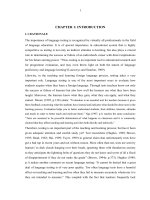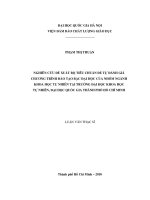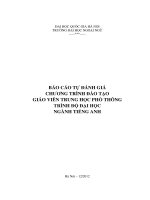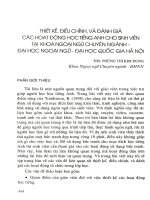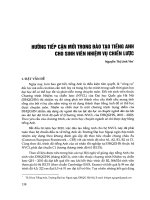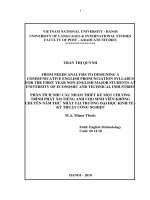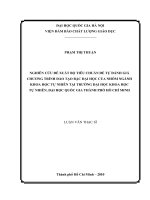Đánh giá chương trình đào tạo tiếng anh cho sinh viên giáo dục mầm non ở một trường cao đẳng ở hà nội
Bạn đang xem bản rút gọn của tài liệu. Xem và tải ngay bản đầy đủ của tài liệu tại đây (1.75 MB, 117 trang )
VIETNAM NATIONAL UNIVERSITY, HANOI
UNIVERSITY OF LANGUAGES AND INTERNATIONAL STUDIES
FACULTY OF GRADUATE STUDIES
HOÀNG THỊ LAN ANH
AN EVALUATION OF THE PRE-SERVICE EFL TEACHERS
TRAINING PROGRAM FOR PRE-PRIMARY STUDENTS AT A
COLLEGE IN HANOI
(Đánh giá chương trin
̀ h đào ta ̣o Tiế ng Anh cho sinh viên giáo du ̣c mầ m
non ở mô ̣t trường cao đẳ ng ở Hà Nô ̣i)
Minor master thesis
Major: English Language Teaching Methodology
Code: 8140231.01
Supervisor: Associate Professor Lê Văn Canh
HANOI - 2018
DECLARATION OF AUTHORSHIP
I hereby state that I, Hoàng Thị Lan Anh, an MA student of the Faculty
of Graduate Studies, University of Languages and International Studies,
Vietnam National University, Hanoi, certify with my signature that my thesis
entitled ‗An evaluation of the pre-service EFL teachers training program for
pre-primary students at a college in HanoI‘ is entirely the result of my own
work. I have faithfully and accurately cited all my sources, including books,
journals, newspaper articles, generics, doctoral dissertations, and online
resources. I declare that I understood the concept of plagiarism and I
acknowledge that my thesis will be rejected in case of plagiarism.
The thesis contains no materials that has been submitted previously, in
whole or in part, for the award of any other academic degree or diploma.
Supervisor‘s signature
Student‘s signature
Associate Professor Lê Văn Canh
Hoàng Thị Lan Anh
i
ACKNOWLEDGEMENTS
I would first like to thank my thesis advisor Associate Professor Lê
Văn Canh of the Faculty of Graduate Studies, University of Languages and
International Studies, Vietnam National University, Hanoi. The door to Prof.
Lê Văn CAnh office was always open whenever I ran into a trouble spot or
had a question about my research or writing. He consistently allowed this
paper to be my own work, but steered me in the right the direction whenever
he thought I needed it.
I would also like to thank all the professors who inspired me
thoroughly during this MA course so that this research project was born and
carried out. Without their passionate lectures and input, the project could not
have been successfully conducted.
Last but not least, I must express my very profound gratitude to my
family and friends for providing me with unfailing support and comfort
throughout my years of study.
I thank you all very much!
ii
ABSTRACT
Pre-service training program are intended to keep practicing teachers
up-to-date as well as tackle issues which occur in their teaching practices.
Given the importance of that mandate, this present study explored the
perceptions of the instructors and trainees of such a program at a college in
Hanoi, Vietnam by focusing on both strengths and weaknesses based on the
related theories, models and previous empirical research findings. The data
gathered from teachers and trainees by means of survey and focus group
interview revealed that the limitations of the program overweighs the
strengths. The program was seen to provide pedagogical and theory
components of a kindergarten English teacher. Yet, it was criticized to be outof-date, less practical-oriented, lack of cultural knowledge, and lack of microteaching. A number of suggestions were offered in the implications of the
critical evaluation for future revision and/or designing a new in-service
program.
iii
TABLE OF CONTENTS
DECLARATION OF AUTHORSHIP ........................................................... i
ACKNOWLEDGEMENTS............................................................................ ii
TABLE OF CONTENTS............................................................................... iv
LIST OF FIGURES ...................................................................................... vii
TABLE OF APPENDICES .......................................................................... vii
LIST OF ABBREVIATIONS ..................................................................... viii
Chapter I. INTRODUCTION AND BACKGROUND ................................ 1
1. Rationale of the study................................................................................ 1
2. The aim and objectives of the study.......................................................... 1
3. The scope of the study............................................................................... 2
4. Methods of the study ................................................................................. 2
5. Design of the study.................................................................................... 3
Chapter II. LITERATURE REVIEW .......................................................... 5
2.1. What is evaluation? ................................................................................ 5
2.2. The purpose of evaluation ...................................................................... 7
2.3. Program evaluation ................................................................................ 8
2.3.1. What is program evaluation? .......................................................... 8
2.3.2. Why program evaluations? ............................................................. 8
2.3.3. What and When to evaluate program? ......................................... 10
2.4. Teacher Training program evaluation .................................................. 11
2.4.1. Teacher training models ............................................................... 11
2.4.2. Peacock’ model ............................................................................. 12
2.5. Teacher training for teaching English to young learners (TEYL) ....... 14
2.5.1. Young Learners ............................................................................. 14
2.5.2. Kindergarten and What are kindergarten children like? ............. 15
iv
2.5.3. Pre-Service Teacher Training Program ....................................... 15
2.5.4. Teaching English to Young Learners (TEYL) ............................... 15
2.5.5. What will include in the teacher training program for teaching
English to young learners? ..................................................................... 16
2.6. Evaluative studies on teacher training for teaching English to young
learners ........................................................................................................ 17
2.6.1. Evaluative studies on teacher training for teaching English ........ 18
2.6.2. Evaluative studies on teacher training for teaching English to
young learners ......................................................................................... 21
Chapter III. METHODOLOGY .................................................................. 23
3.1. The study context ................................................................................. 23
3.2. Methods ................................................................................................ 24
3.3 Participants and Instruments ................................................................. 24
3.3.1. Participants ................................................................................... 24
3.3.2. Instruments .................................................................................... 24
3.3.3. Procedures .................................................................................... 25
3.3.4. Data Analyses................................................................................ 26
Chapter IV. FINDINGS AND DISCUSSION ............................................ 28
4.1. Findings from the student surveys ....................................................... 28
4.1.1. Professional knowledge and skills ................................................ 28
4.1.2. Personal knowledge and skills ...................................................... 29
4.1.3. Teaching approaches .................................................................... 31
4.2. Findings from the teacher interviews ................................................... 31
4.2.1. Professional knowledge and skills ................................................ 31
4.2.2. Personal development ................................................................... 33
4.2.3. Methodological issues ................................................................... 34
4.3. The strengths and limitations of the program ...................................... 34
v
4.3.1. Strengths of the program............................................................... 35
4.3.2. Limitations of the program ........................................................... 35
Chapter V. CONCLUSION ......................................................................... 38
5.1. Summary .............................................................................................. 38
5.2. Implications .......................................................................................... 39
5.3. Limitation and further research ............................................................ 40
References ...................................................................................................... 41
Appendices ........................................................................................................I
vi
LIST OF FIGURES
Figure 3.1: Five stages of content analysis ..................................................... 27
TABLE OF APPENDICES
Appendix 1: Pronunciation Syllabus.................................................................. I
Appendix 2: Listening Syllabus 1 .................................................................... II
Appendix 3: Listening Syllabus 2 ................................................................... IV
Appendix 4: Listening Syllabus 3 ..................................................................VII
Appendix 5: Speaking Syllabus 1 .................................................................... X
Appendix 6: Speaking Syllabus 2 ................................................................... XI
Appendix 7: Speaking Syllabus 3 ..................................................................XII
Appendix 8: Reading Syllabus 1 .................................................................. XVI
Appendix 9: Reading Syllabus 2 .................................................................. XIX
Appendix 10: Reading Syllabus 3 ............................................................... XXII
Appendix 11: Writing Syllabus 1............................................................... XXV
Appendix 12: Writing Syllabus 2........................................................... XXVIII
Appendix 13: Writing Syllabus 3............................................................... XXX
Appendix 14: Methods to make young learners familiar with English Syllabus
................................................................................................................ XXXIV
Appendix 15: Activities to Make Young Learners Familiar with English
Syllabus ............................................................................................... XXXVIII
Appendix 16: Speaking Translation Syllabus ................................................ XL
Appendix 17: Writing Translation Syllabus .............................................. XLIII
Appendix 18: English Literature for Young Learners Syllabus ................. XLV
Appendix 19: Grammar Syllabus ...............................................................XLIX
Appendix 20: Level 3 in Vietnamese Standardized Test of English
Proficiency ..................................................................................................... LII
Appendix 21: The survey form .................................................................... LVI
Appendix 22: Focus Group Interview ......................................................... LVII
Appendix 23: Link between Research Questions, Data Sources and Data
Collection Methods .................................................................................... LVIII
vii
LIST OF ABBREVIATIONS
PEF
Pre-primary Education Faculty
EF
English Faculty
EPTP
English pre-service training program
NCE
National College for Education
VSK
Values, Skills and Knowledge
TEYL
Teaching English to Young Learners
EFL
English as a Foreign Language
viii
Chapter I
INTRODUCTION AND BACKGROUND
1.1. Rationale of the study
At this moment, teaching English for small children in the kindergarten
is one of the top issues throughout the world in general and in Vietnam in
particular. According to the top linguists and experts, the three – to - five –
year – old period of time of a child is the golden age for learning a foreign
language. In addition, preschool teachers play a very important role in the
child's English learning. In fact, recent surveys conducted by some experts at
National College for Education show some problems. English teachers do not
really understand psychological and physiology of preschool age. On the
other hand, preschool teachers are limited in their ability to speak foreign
languages, which results in poor pronunciation and / or use wrong words in
situations. This is very influential to children‘s English accepting process in
the golden period. Therefore, the training of English teachers for small
children is extremely important and urgent today. In my opinion, one of the
prerequisites for such high-quality human resource training is the teaching
program for junior students, who will be English teachers for children in the
kindergarten in the near future. However, from my teaching experience as
well as my collecting data from students, I realize that the contemporary preservice training program has not really met the requirements of necessary
competence and quality of an English teacher for small children. Therefore, it
is very necessary for me to conduct research: ―An evaluation of the preservice EFL teachers training program for pre-primary students at a college in
Hanoi‖.
1.2. The aim and objectives of the study
The main purpose of this study is to point out the strong points and the
1
weak ones of the temporary pre-service EFL teachers training program at
National College for Education.
The objectives of the study are to evaluate the strength and the
limitation of the temporary pre-service EFL teachers training program at
National College for Education. At which point, recommendations are hoped
to give to improve the weak points of the temporary pre-service EFL teachers
training program at National College for Education. The research question is:
What are the strengths and limitations of the current English preservice training program (EPTP) for teaching kindergarten children at
National College for Education (NCE) regarding the professional knowledge
and skills?
1.3. The scope of the study
The study is concerned with the assessment of the current English
teaching program for pre-teachers in the kindergarten. It was conducted at
National College for Education, Hanoi, Vietnam. The data was collected
through a survey by using questionnaires for twenty-five – female - senior
students at Pre-primary Education Faculty (PEF), and interviews for five
lecturers at English Faculty (EF).
1.4. Methods of the study
The study was carried out by some steps as follows:
First of all, the survey questionnaire for last year students was
employed to find out their opinions about the temporary pre-service EFL
teachers training program at National College for Education. Moreover, the
students‘ solutions for the limitation that their curriculum needs adjusting
were recorded.
Secondly, personal interviews for instructors at English faculty were
proceeded to compare between their thought and their students‘ real
2
situations. From their sharing and their students‘ offers, it helps all of them to
have a deeper understanding about their current training program.
After that, the data was collected, sorted, and analyzed quantitatively
and qualitatively to obtain results.
Finally, recommendations for the solutions to the limitation of the
temporary training program to improve for better curriculum for the next
courses.
1.5. Design of the study
This present study consists of five chapters in a close link together. In
this first chapter Introduction, the initial part briefly introduces the rationale
of the study and the background to which the study was set up. The aim and
objectives of the study were discussed in the second part followed by the
scope of the study and a brief introduction of the methods. The design of the
study was proposed as the last part of this chapter.
Chapter two presents the theoretical framework and the literature
review of the study. First, it sought to answer the question what evaluation
and its purpose are. Next, it discusses the components of a program evaluation
in details to set the theoretical background. After that, it attempted to propose
teacher training models and Peacock‘s (2009) model as an example. In setting
the background, the components of teaching English to young learners were
introduced before a critical review of previous findings on teacher training
program for TEYL.
Chapter three discusses the context of the study as an initial part before
discussing the methods used. In this chapter, the participants and instruments
were discussed in details to validate the data collection procedures and the
analysis of the data.
3
Chapter four presented the findings and discusses the findings in
comparisons with previous empirical studies. This chapter aimed at answering
the research question and validating the findings of the study. The last chapter
recapped the whole study project and restated the findings before proposing
some suggestions depending on the findings and the limitations as well as
further research directions were offered.
4
Chapter II
LITERATURE REVIEW
2.1. What is evaluation?
Evaluation is the structured interpretation and giving of meaning to
prediction or actual impacts of proposals or results. It looks at original
objectives, and at what is either predicted or what was accomplished and how
it was accomplished. So evaluation can be formative that is taking place
during the development of a concept or proposal, project or organization, with
the intention of improving the value or effectiveness of the proposal, project,
or organization (Crooks, 2001). It can also be summative, drawing lessons
from a completed action or project or an organization at a later point in time
or circumstance (Bloom, Madaus, & Hastings, 1971).
In Patton‘s (1987) opinion , evaluation is a process that critically
examines a program. It involves collecting and analyzing information about a
program‘s activities, characteristics, and outcomes. Its purpose is to make
judgments about a program, to improve its effectiveness, and/or to inform
programming decisions.
According to some other researchers (DuBois, Portillo, Rhodes,
Silverthorn, & Valentine, 2011; Ross, Elipse, & Freeman, 2004), evaluation is
the systematic assessment of the design, implementation or results of an
initiative for the purposes of learning or decision-making.
-Systematic: An evaluation should be as systematic and impartial as
possible (Ross et al., 2004). An evaluation is methodical, providing
information that is credible, reliable, and useful to enable the incorporation of
lessons learned into decision-making process of users and funders. Evaluation
is based on empirical evidence and typically on social research methods, thus
on the process of collecting and synthesizing evidence (Ross et al., 2004).
5
Conclusions made in evaluations encompass both an empirical aspect and a
normative aspect (Fournier, 2005). It is the value feature that distinguishes
evaluation from other types of enquiry such as basic science research, clinical
epidemiology, investigative journalism, or public polling.
- Assessment: Evaluation assessment considers value, merit, worth,
significance or quality (Scriven, 1993). It may aim to identify what works, for
whom, in what respects, to what extent, in what contexts, and how (Pawson,
Tilley, & Tilley, 1997). It may examine expected and achieved
accomplishments, the results chain, processes, contextual factors and
causality in order to understand achievements or the lack thereof (UNEG,
2005). Evaluation may focus on a broad range of topics including relevance,
accessibility, comprehensiveness, integration, fulfillment of objectives,
effectiveness, impact, cost, efficiency, and sustainability (Patton, 1987). The
evaluation process normally involves some identification of relevant
standards, some investigation of performance on these standards, and some
integration or synthesis of the results to achieve an overall evaluation
(Scriven, 1993).
- Initiatives: Evaluation can focus on any kind of initiative such as
programs, projects, sub-programs, sub-projects, and/or their components or
elements (Scriven, 2003; Yarbrough, Shulha, Caruthers, & Hopson, 2011).
In my opinion, evaluation means value. It is the process of recording,
storing and providing information to the evaluator of something. Review is
systematic, independent and documented to receive objective evidence and to
determine the level of performance of the evaluation criteria. The assessment
should be objective, accurate by gathering real, objective, regular and
continuous data. Meaningful words close to the rating are criticism, comment
and review.
6
2.2. The purpose of evaluation
Experts say that evaluation is essential in education. Evaluation can
improve the current program. It is important to periodically organize the
performance of the assessment and program adjustment. Evaluations help us
find the areas that need improvement and help us achieve our goals more
effectively. When we know what is ineffective, what works, we promote the
educational environment. In addition, evaluations allow us to prove that the
current program is successful or unsuccessful. Review information is
collected from real data, undergoing analysis and final conclusions.
Therefore, evaluations can help us prove the impact of the program
being used.
Evaluation can be conducted for the purposes of decision making,
judgements,
conclusion,
findings,
new
knowledge,
organizational
development and capacity building in response to the needs of identified
stakeholders leading to improvement, decisions about future programming,
and/or accountability ultimately informing social action ameliorating social
problems and contributing to organizational or social value (Patton, 1987;
Yarbrough et al., 2011).
Institute of Museum and Library Services believes that the two most
important purposes of evaluation are:
- to provide the information needed for good decisions on priorities,
resource deployment and program design.
- to help communicate the value of initiatives.
In my point of view, in education, evaluation is understood as the
process of forming judgments:
- guess the results of the work, based on the analysis of the information
obtained against
7
- targets, standards set, to propose appropriate decisions to improve the real
- adjusting, improving the quality and effectiveness of education
- through this understanding, evaluation in education not only
recognizes the real situation but also deals with it
- making decisions that change the status of education in the desired
direction of society.
2.3. Program evaluation
2.3.1. What is program evaluation?
Evaluation is the systematic application of scientific methods to assess
the design, implementation, improvement or outcomes of a program (Ross et
al., 2004).
Program evaluation is a systematic approach to collecting, analyzing
and using information to answer questions about projects, policies, and
programs, and their effectiveness. In both the public and private sectors,
stakeholders often want to know if the programs they are sponsoring,
implementing, voting, receiving or opposing are creating the intended effect.
To sum up, program evaluation is systematic research conducted
periodically or on a special basis to evaluate program performance. As tools
to support good management practices, they help managers determine if there
is a need for timely adjustments in program design to improve the rate or
quality of performance associated with committed resources or not. The
assessment also helps educators and managers quantify the effects of the
program.
2.3.2. Why program evaluations?
The main purpose of a program evaluation may be to "determine the
quality of a program by constructing a judgment." (Hurteau, Houle, &
Mongiat, 2009). And to manage linked programs to measure and display
8
results. Therefore, there is strong emphasis on good management practices.
Good management practices include the key action of the program manager to
decide, preferably on their own initiative, to carry out the assessment. The
next is to use the results. Ideally, programs should collect assessment
information as a matter of common management practice because evaluation
is a tool that can help programs achieve managerial excellence. The
assessment does this by serving two important purposes - program
improvement and accountability. Many evaluations will be designed to serve
both purposes.
Improvement: Assessment helps managers measure the effectiveness of
their programs by estimating the extent to which they achieve the desired
results and by determining if improvements are needed to increase efficiency
for goals or not. Evaluation helps program managers proactively optimize the
performance of the program. Evaluations provide actionable information on
program activities that are not being implemented as expected, resulting in
ineffective outputs, unmet needs or expectations, and results under forecast.
Managers can use this information to request more resources or modify the
program design to improve its performance. A program of implementation of
assessment activities to obtain timely information in the planning process,
budgeting, implementation and other management cycles to make continuous
improvements will achieve success larger than no activities.
Accountability: Assessment helps the program manager to demonstrate
internal and external accountability of public resource use. This includes
demonstrating responsible management in a sophisticated way, establishing
evidence that the objectives are being met or that services are being provided
as promised, and quantifying "real" present "of the program. Accountability,
in part, is driven by the need to address internal and external needs and
9
expectations. A program that can calculate for its public investments by
demonstrating progress and results is more likely to be seen as more
successful by the right people and stakeholders.
2.3.3. What and When to evaluate program?
What and when to evaluate program performance depend on several
related considerations (Kiely & Rea-Dickins, 2005), such as:
- The process of the program in its life cycle (creating the program, the
current program or the nearly ending program)
- The decision is informed by evaluation information during planning,
budgeting, implementation, reporting of benefits and communication cycles
- Any need to meet program evaluation expecting request.
- Ideally, a comprehensive strategy and plan for the overall program
evaluation should be developed to outline the planned assessment over a
multi-year time frame, so the information is generated:
+ is timely, not too often not enough time to make recommendations
from the assessment
+ in line with the management and decision-making process of the
program
+ in addition to other program data collection activities
Determining the timing of program performance assessments will take
into account the relevant considerations described above (e.g. the phase of the
program cycle, the timing of the program decisions and the assessment
requirements). In general, program activities are selected or the whole
program should have some evaluation done over a period of five to two or
three years.
Currently, internal program issues include (Kiely & Rea-Dickins,
2005):
10
- Day-to-day management concerns
- Professional relationships
- Language leaners attitudes
- General integration
- Contribution to aims of school
- Internal administration systems
- Contributions to teaching within the English Department
- Professional impact
To sum up, in school today, teaching is not just about teaching
something but also teaching living skills. Renovating teaching methods is an
urgent need to improve the quality of teaching. Innovative teaching methods
require a coherent innovation of content from textbook programs, teaching
methods to teaching-learning outcomes. Assessment and evaluation program
play a very important role in improving the quality of training. The results of
the assessment are the basis for adjusting teaching, learning and educational
management. Failure to do that will result in a great misperception in the use
of human resources. Innovative testing has become a pressing need for the
education sector and for today's society. Accurate and objective evaluation
will help learners with confidence, enthusiasm, enhancement in the creative
ability in learning.
2.4. Teacher Training program evaluation
2.4.1. Teacher training models
In this paper, the term model (or approach) is meant to characterize the
overall way in which a pre-service program presents or delivers knowledge to
its learners. The Apprentice-Expert Model (Day, 1991) is the oldest form of
professional education and is still used today in ESL teacher education, albeit
rather limited. Its conceptual basis, however, is widely used in practical
11
courses in which students work with classroom teachers, often referred to as
collaborative teachers. The underlying assumptions underlying this model are
as follows. In its most basic form, the craft model consists of learners or
beginners working closely with specialist teachers. Trainees are obliged to
learn by imitation all the teaching techniques used by experienced teachers.
Knowledge is acquired as a result of observing, guiding, and practicing.
The applied science model put forward by Wallace (1991). This model
gained power from the achievements of experimental science. The applied
science model is based on the following assumptions: Teaching is a science
and so can be tested in a reasonable and objective way. Teachers learn to
become teachers by teaching research-based theories. These theories are being
communicated to the students only by those who are considered professionals
in the particular field. Teachers are supposed to be educated when they
become proficient enough to apply these theories in practice.
In the reflective model (Clegg, 2000), reflective practice has become a
dominant pattern in the study of teacher language education and programs
around the world. But it is not an innovation in teaching. It has its origins in
the work of some theorists and educators. The reflection model is based on
the assumption that teachers develop their professional competence by
reflecting their own practices. In other words, a teaching experience is
revoked and considered to achieve an evaluation and provide input to future
plans and actions.
2.4.2. Peacock’ model
Peacock‘s (2009) model is a recent model of assessment in the context
of Turkish universities. According to Coskun and Daloglu (2010) , Peacock‘s
model has been effective in providing multidimensional feedback about the
program being evaluated. Most specifically, Peacock‘s questions have
12
encouraged the participants to consider the following aspects of the program:
its philosophy, the knowledge provided through the program, the reflection
student teachers engage in during the program and the reflective skills they
develop, relationship among the courses in the program, the types of
competences developed through the program, and the extent to which student
teachers‘ need are met. Contrary to most program evaluation models that have
chronological approach that addresses the planning, implementation, and
evaluation phrases of a program, Peacock‘s model has enabled addressing
components that are critical in educating English language teacher candidates.
Minott and Young (2009) considered reflexive diary recording as a
source of evaluation of training programs. And more specifically, they have
developed a hybrid approach that is published through reflective assessment
and journaling. Although the benefits of using a variety of sources for
evaluating a previously highlighted training program by Darling-Hammond
(2006) and Schwille, Dembélé, and Schubert (2007), their research has
introduced the concept of a mixed evaluation method that includes both diary
and reflective logs.
Similarly, the research conducted in Singapore, Chong and Cheah
(2009) explain the development as well as the foundational values of
concepts, skills and frameworks, and through an assessment program, they
looked at the validity and reliability of the items developed through the VSK
(Values, Skills and Knowledge) framework to evaluate the values, skills and
knowledge that graduates receive. Through their preparation program, they
become English teachers. Based on the data they collected from last year
students preparing for graduation, they stated that while the VSK framework
provides trainees with the ultimate knowledge of teaching and learning, it is
isolated between the ideal theory and the practical implementation steps. They
13
assert that trainees should consider initial education as a part of continuing
high-quality learning and they need to develop a problem-solving skill and
attitude from learning to accumulating experience through reflection. Hence a
challenge to the teacher's education then becomes one of the perceptions of
the whole experience and knowledge that have been managed contextually as
a complement to discuss the framework for informing the practice of teaching
and learning.
In conclusion, these models focus on assessing the personal and
professional development of the teachers in the training program.
2.5. Teacher training for teaching English to young learners
(TEYL)
2.5.1. Young Learners
Young Learners are a compulsory term for underage students. The term
that embraced fashion in the early nineties reflected a declining trend in the
age and expanded access to English learning for young people in many
countries around the world.
In this interpretation, the term 'young people' covers all ages and stages
of development of children from infants, young children and older children,
through adolescents, adolescents and children.
In other explanations, 'young people' is a term used to refer to children
from the first formal school year (usually 5-7 years) to when they are 11-12
years of age or when They move from primary to secondary school. This is an
interpretation that is generally or implicitly accepted by publishers and
inspection boards. In this interpretation, a 'young learner' grows labeled
something else, usually a teenager, in adolescence. In this explanation, there
is often an additional term for 'very young learners' that are used to refer to
pre-primary children aged 3-6.
In different brochures for language courses, teaching resources and
14
camps, you can also find the term 'young learner' that is used to cover a wide
range of different age groups. 8-16, 4-14, 9-15, 5-16, etc.
2.5.2. Kindergarten and What are kindergarten children like?
Kindergarten is defined as ‗A formally organized pre-first grade class
for children usually five years old‘ (Unger, , p. 626). Now considered an
essential part of formal education worldwide, kindergarten originated from
Germany in 1837 when ‗German pedagogue Friedric Froebel discovered that
children seemed to learn more from play than they did from strict, formal,
direct instruction and rote memorization‘ (Unger, 2014, p. 626).
Kindergarten children are like other children in many ways. They have
similar developmental, physical, and behavioral
characteristics that
characterize them as kindergarteners—children ages five to six. Yet, at the
same time, they have characteristics that make them unique individuals
(Loban, 1976).
2.5.3. Pre-Service Teacher Training Program
The program purports to prepare university graduates to undertake
teaching responsibilities. There is an attempt to combine theory and practice
in such a way that theory will be based on the accumulated results of practice,
while at the same time practice should possess organizational and systematic
characteristics deriving from generalization and principles. One of the
program's purposes is to enrich each graduate's potential with all necessary
experiences and abilities that will render him capable of interpreting
pedagogical theories and transforming the content of various cognitive
subjects, so as to be able to play a successful role both in class and in the
broader school environment.
2.5.4. Teaching English to Young Learners (TEYL)
Teaching English to Young Learners is a course for all elementary
school teachers. It aims to provide teachers with the knowledge and skills
15
needed to support the learner through providing compelling and motivational
lessons.
TEYL is an exciting and rewarding career and opportunity that exists
throughout the world to teach language to young learners. Although this
course focuses on teaching English to young learners, it is also suitable for
teachers of other languages who wish to develop their language skills and
practice.
2.5.5. What will include in the teacher training program for teaching
English to young learners?
In his book ‗Teaching English to Young Learners,‘ Nunan (2010)
clearly states what it takes to include to teach English as a second or foreign
language to young learners. The key aspects of TEYL include:
- Learning and development of young learners
- Theories of young learner learning and development
- Characteristics of young learners
- Learning styles
- Language acquisition
- The young learner classroom
- Young learner lessons
- Lesson approaches
- Lesson structure and planning
- Classroom management
- Error and error correction
- Adapting EFL techniques
- Teaching language to young learners
- Teaching vocabulary
- Teaching grammar
16

